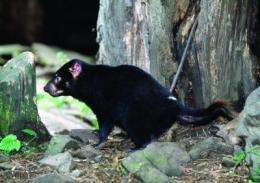Culling can't save the Tasmanian devil

Culling will not control the spread of facial tumour disease among Tasmanian devils, according to a new study published this week in the British Ecological Society's Journal of Applied Ecology. Unless a way of managing the disease is found, the iconic marsupial could become extinct in the wild within the next 25 years.
Testing and culling infected animals is widely used to control disease in livestock, but its use in wild animals is controversial. Between 2004 and 2010, culling trials of devils on the Forestier Peninsula - an almost completely isolated peninsula in south-eastern Tasmania - found that the strategy failed to halt the spread of Tasmanian Devil Facial Tumour Disease (DFTD).
In this new study, Nick Beeton of the University of Tasmania and Professor Hamish McCallum of Griffith University devised models to test the impact of more aggressive culling. They found that an unfeasibly large number of devils would need to be culled to control the disease.
According to Mr Beeton: "For all the models we used, we found the removal rate required to suppress disease was higher than that which would be feasible in the field. "Disease suppression can only work if you can catch enough of the infected animals in the population to make sure the disease won't bounce back. Our models show that even for a trappable animal like the Tasmanian devil, catching enough of them to eradicate disease is a tall order."
The latest results confirm the view now held by the Save the Tasmanian Devil Program – an Australian and Tasmanian government initiative – to end culling as a way of controlling the disease.
Efforts to save the devil now centre on three other strategies – setting up insurance populations, finding genetic resistance and developing a vaccine.
"Given the limited progress in developing vaccines against human cancers, despite huge investment in research, hoping a vaccine can be developed against DFTD seems optimistic," Professor McCallum says.
The disease seems to be increasing less rapidly in devils living in north-western Tasmania, suggesting this population may have some genetic resistance to the disease.
At least 200 devils are already in captivity in Australian mainland zoos and disease-free populations of devils in large enclosures are being established in Tasmania and mainland Australia.
According to Mr Beeton: "It is important also to establish disease-free wild living populations on islands or in very large fenced landscapes. Wild animals are more suitable for reintroduction to the Tasmanian mainland if needed."
DFTD was first detected in Mount William in north-eastern Tasmania in 1996. Since then the infectious cancer, thought to be transmitted by biting during mating, has spread across most of the devil's range. As a result, populations of the world's largest surviving marsupial carnivore have declined by 60%.
More information: Nick Beeton and Hamish McCallum (2011), 'Models predict that culling is not a feasible strategy to prevent extinction of Tasmanian devils from facial tumour disease', doi: 10.1111/j.1365-2664.2011.02060.x , is published in the Journal of Applied Ecology on Wednesday 5 October 2011.
Provided by Wiley


















